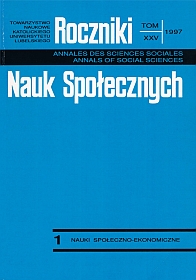Granice kultury symbolicznej. Perspektywa antropologiczna
Abstrakt
within symbolic cultures - which, when crossed, chaos and feeling of senselessness, and instability sneak into man’s experience?
The paradigm of post-modernist culture concentrates mainly on the concept of sense. To create or „unveil” it is an essential element of cultural process. Among many meanings of sense the basic one is that which refers to being-value as the source of sense.
Questioning this concept of sense - in the case of post-modernist destruction - does not mean „death” of the problem of sense. Nor does it mean in the ethnology of religion, respectively, „death” of the problem of Sacrum.
Geertz brought to our minds the image of culture in the form of manuscript. It is full of blanks and undertones, yet there is some minimum of coherence.
Among many cultural symbols Geertz lists those which point to an idea of order, broadly speaking, a contradiction to chaos. This idea is an antidote to an existential and basic fear, a fear that stems from disharmony between that which is and that which should be. Mention in the title has been made of borders. They are borders of, sometimes different, paradigms of symbolic culture. It seems that they are included in the consensus (Geertz) as to the basic values like life, good, and bad. In the religious language they mean recognition for the category of Sacrum as a transcultural value.
Copyright (c) 1997 Roczniki Nauk Społecznych

Utwór dostępny jest na licencji Creative Commons Uznanie autorstwa – Użycie niekomercyjne – Bez utworów zależnych 4.0 Międzynarodowe.


